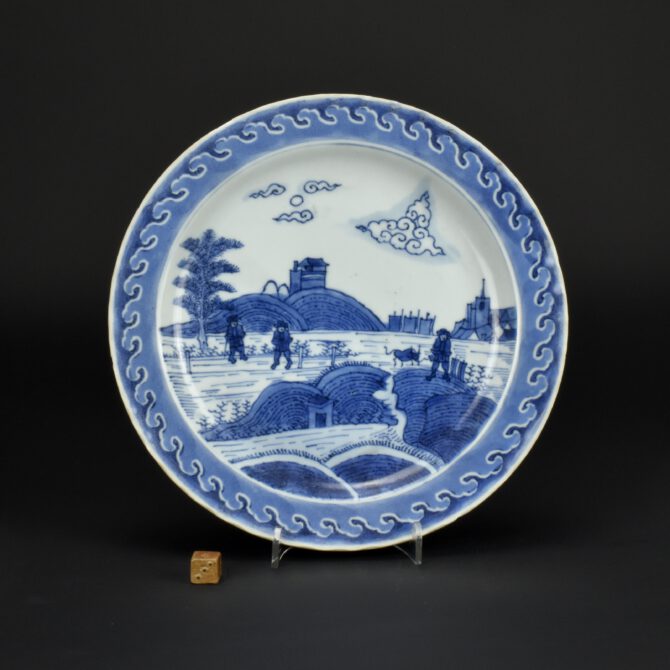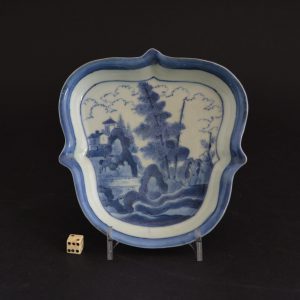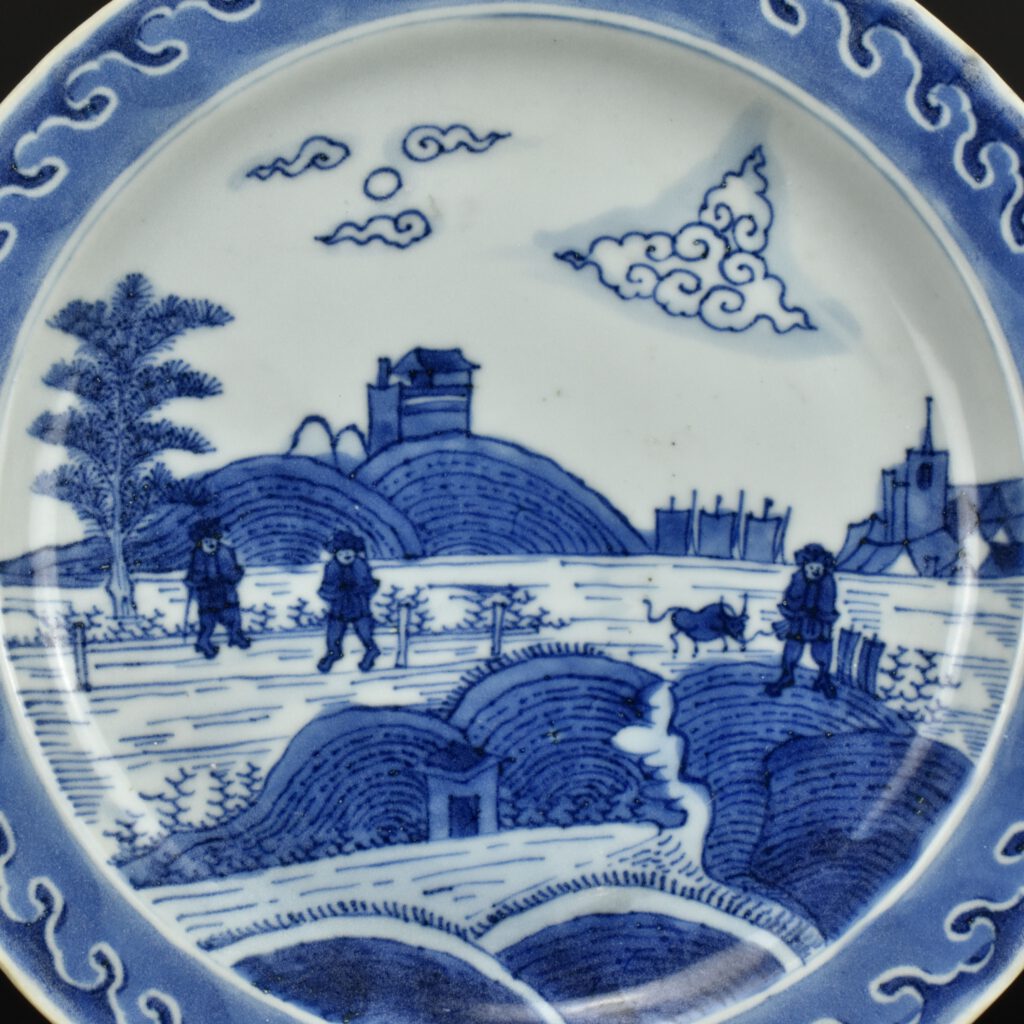
A Van Frytom Style Porcelain Plate from the Ca Mau Cargo
A Yongzheng Blue and White Porcelain Plate from the Ca Mau Cargo c.1723-1735. This shaped plate is painted in the style of a famous Dutch Delft artist, Frederik Van Frytom (1632 – 1702). The scene is thought to represent Scheveningen, on the coast of the Netherlands, with its Church, ships, and sand dunes, it had been referred to as Deshima Island but all Van Frytom’s work depicts the Netherlands. It is heavily potted with little variation in thickness, that is probably because it was based on a Japanese version of this design. This plate has ‘oriental’ style clouds in the landscape. As far as I’m aware, all the plates of this design from the Ca Mau Cargo have these clouds, where as the none-shipwreck versions have clouds that are in the style of Van Frytom. The moulded undulating border is quite distinctive, the painting of the border uses wax resist to separate the dark outer blue with the paler cobalt wash which frames the design. This moulded and painted border is used on several other Japanese porcelain designs which are dated between to c.1690 and 1730.
See Below For More Photographs and Information.
SOLD
- Condition
- The glaze is in very good condition, a small chip to the back rim - see Photograph Gallery below.
- Size
- Diameter 22.3 cm (8 3/4 inches)
- Provenance
- Ca Mau Cargo c.1723-1735. R&G McPherson Antiques stock number 14796, I purchased it from a dealer in London on the 8th of August 2003.
- Stock number
- 27461
- References
- For a Van Frytom style Japanese porcelain teabowl see : The Burghley Porcelains, An Exhibition from The Burghley House Collection and Based on the 1688 Inventory and 1690 Devonshire Schedule (Japan Society, New York,1986) page 158, plate 54, illustrated on page 159. For a Japanese teabowl of the same pattern as the present example see our : Sold Items 21456. For more about this delft artist see : Frederik Van Frytom 1632 - 1702, Life And Work Of A Dutch Pottery-Decorator By A.Vecht ( Scheltema and Holkema NV, Amsterdam, 1968 )
Information
Frederik Van Frytom :
The Dutch artist Frederik Van Frytom (1632 - 1702) was an important painter of Delft pottery, perhaps the most important Delftware painter. His style of painting fits very well within the 17th century Dutch landscape tradition, it includes typically Dutch scenes, rustic landscapes with small bridges, pollarded willow and cows scattered about small fields. His ceramic painting technique was individual, more akin to painting than merely filling in a design on a ceramic body. Van Frytom`s connection with oriental ceramics stems from a series of small blue and white Delftware dishes painted by him that were made for the Tea-Ceremony in Japan or as proto-types for the Japanese to copy, the bases of which were marked MB and dated 1684 (See Frederik Van Frytom 1632 - 1702, Life And Work Of A Dutch Pottery-Decorator, A.Vecht, Scheltema and Holkema NV, Amsterdam, 1968). The best known of Van Frytom`s designs fpund on Japanese porcelain are the so-called Deshima Island pattern, now known to be a view of Holland. Porcelain plates of this pattern, as well as related designs, were produced at the Arita Kilns in Japan and then in China at the Jingdezhen kilns, related designs also occurs on Chinese soft-paste porcelain. Plates and dishes of the so-called Deshima Island pattern dating to the Yongzheng period (1723-1735) were sold at Sotheby`s Amsterdam Sale of Chinese Porcelain from the Ca Mau Cargo, "Made in Imperial China". This Western style was then re-used, probably via Japanese or Chinese interpretations, in England at The Bow Factory using soft-paste porcelain, at least some of these Bow pieces closely relate to Chinese soft-paste porcelain versions of the design. However, the Chinese soft-paste examples are quite late in date, perhaps about 1750, so it might well be possible that they are based on the Bow examples that are copying the Japanese or Chinese versions of the Delft. A complex and somewhat confusing inter-connection of design and trade. Japanese and Chinese porcelain in the Van Frytom style are show together with original Delft examples by Christiaan Jörg in 'Fine and Curious, Japanese Export Porcelain in Dutch Collections' (Christian J.A. Jorg, Hotei Publishing, 2003. ISBN 90-74822-16-9) pages 240 to 249.
A Delftware orginal 1684

Japanese 'Van Frytom' Style Van Frytom Porcelain
from Robert McPherson Antiques
Below are a few late 17th and early 18th century Van Frytom style Japanese porcelain objects.
See Robert McPherson Antiques - Sold Items, search 'Van frytom'.






Groninger Museum, Netherlands

The Ca Mau Cargo
Dating is often one of the most contentious issues when researching a shipwreck site. In this case, an approximate date is not difficult to ascertain. Coins that date from the Kangxi Period (1662-1722) were recovered from the wreck. Chinese coins, like their Western counterparts, were often in circulation over a long period of time, therefore these coins do not necessarily give a Kangxi date for the wreck, but do provide a `not before` date. Most importantly of all, a group of wine cups were recovered from this shipwreck, bearing a four-character Yongzheng mark, indicating that they were made during the Emperor Yongzheng`s reign, which lasted from 1723 to 1735. The style of the potting, glazing and painting of these cups are all consistent with other known pieces from the Yongzheng period. Other porcelain removed from the wreck is also consistent in style, which suggests that all the porcelain was made during the same period. For a number of years now, I have suspected that a considerable amount of porcelain ascribed to the reign of the Emperor Kangxi (1662-1722) was in fact made during the shorter reign of his son Yongzheng (1722-1735). After studying the two styles over a long period of time, it has become apparent to me that many pieces of Yongzheng porcelain previously had been wrongly identified as belonging to the better-known period of Kangxi. The Ca Mau wreck, I believe, helps re-establish the importance of the large output of Chinese export porcelain during the Yongzheng period. It must be remembered, however, that a dynastic change did not necessarily influence the styles of Chinese export porcelain. The first year of Yongzheng by no means saw a sudden shift in ceramic styles. The Chinese porcelain export trade was a commercial enterprise and popular patterns were used for as long as demand continued. Change as well as technical innovation occurred but it was the changing demands of customers that brought about a change in style from the late Kangxi period to the Yongzheng Period, indeed styles always change because producers try to understand what will sell at any given moment. These changes are evident in the ceramics recovered from the Ca Mau cargo. The use of `Pencilled` decoration is an example. The decoration is painted in outline only, without the use of tonal washes. The style is found in some late Kangxi porcelain but it reached maturity during the Yongzheng period. The profile of some of the tea bowls became less rounded, and the manner of painting faces and hair also changed during this period. All these elements are to be found in the porcelain recovered from the shipwreck. The cargo forms a most useful historical bridge between the Kangxi porcelain of the Vung Tau Cargo produced during the 1690`s and the Qianlong porcelain produced in 1750-1751, recovered from the wreck of the Geldermalsen, now known as the Nanking Cargo.
Robert McPherson Antiques - Sold Archive.
A Rare Ca Mau Porcelain "Sea Sculpture" or "Authentic-Recycled" Teabowls. See Provenance and References where these fanciful sales terms are used. This Yongzheng (1723-1735) porcelain object consists of 12 blue and white teabowls fused together when the so-called Ca Mau ship caught fire. This shipwreck is important in that some porcelain teabowls had a Yongzheng (1723-1735) four-character reign mark, helping to date the wreck (see below the photograph gallery for more details). It is thought the ship wreck happened because of a fire on board, clearly the temperature reached must have been considerable to melt porcelain.








